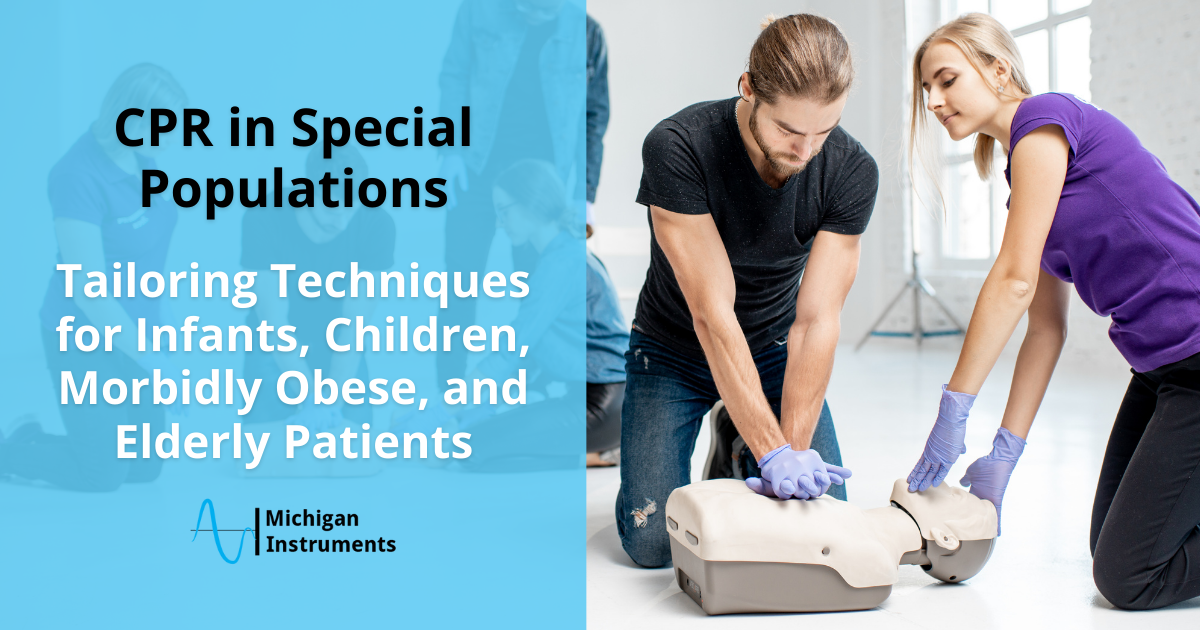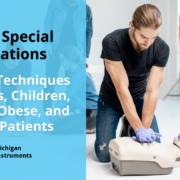
CPR is a critical life-saving technique that can make all the difference in emergencies. However, tailoring CPR efforts is critically important for special populations such as infants, children, the morbidly obese, and elderly patients.
Each year in the United States, over 15,000 hospitalized children receive CPR for cardiac arrest, and between 10-20% do not survive the event. Similarly, for those who are hospitalized and over the age of 65, only about 18% survive. In addition, with the rise of heart conditions related to obesity, there is an increase in the need for CPR to treat larger patients.
Manual CPR Techniques for Special Populations
In emergency situations involving infants, children, obese and elderly patients, manual CPR techniques play a vital role in sustaining life until advanced medical care can be provided. Careful attention to detail, such as adjusting compression depth, rate, and airway management based on the patient’s age and condition, is crucial for effective resuscitation.
Healthcare providers must also consider factors like anatomical differences due to age, size and condition, the potential for rescuer fatigue, and more, emphasizing the need for specialized training and ongoing skill development in CPR for these special populations.
Let’s take a look at the best practices for CPR for some of these specialized populations.
Infants: Delicate Care for Tiny Lives
- Use gentle, controlled chest compressions to avoid harm to the fragile rib cage.
- Position the infant on a firm surface with their head in a neutral position for proper airway alignment.
- Adjust compression depth (about 1.5 inches) and rate (100 to 120 compressions per minute) based on the infant’s size and condition.
Children: Precision and Care for Growing Bodies
- Adjust compression depth (approximately 2 inches) based on the child’s age and size.
- Maintain a compression rate of 100 to 120 compressions per minute, synchronized with proper ventilation.
- Use age-appropriate airway management techniques to ensure clear airflow.
Elderly Patients: Adaptive CPR for Aging Bodies
- Adjust compression depth (2 inches) and rate (100 to 120 compressions per minute) based on the patient’s chest size and condition.
- Continuously monitor vital signs and adjust CPR technique as needed.
- Consider potential rescuer fatigue during prolonged CPR efforts and rotate providers if necessary.
The Problem with Manual CPR in Special Instances
While manual CPR techniques are critically important, they can pose challenges in providing consistent and effective compressions, especially with the morbidly obese where adequate compression depth can be particularly difficult.
Factors such as rescuer fatigue, variations in compression depth and rate, and the need for precise adjustments based on each individual patient can impact CPR outcomes.
How Michigan Instruments Can Help
Automated CPR is not recommended for infants or children. However, Michigan Instruments does offer advanced automated CPR devices, the Life-Stat and Thumper, designed to address some of the challenges of manual CPR in adults, including the morbidly obese and elderly.
- Consistent Compressions: Michigan Instruments’ automated devices provide consistent and controlled chest compressions, reducing the risk of variability in depth and rate.
- Adaptive Settings: Our devices can adapt compression depth and rate based on patient demographics, ensuring tailored CPR delivery.
- Reduced Rescuer Fatigue: Automated devices alleviate rescuer fatigue by providing reliable and uninterrupted compressions during resuscitation efforts.
By leveraging automated CPR technology from Michigan Instruments, healthcare providers can deliver high quality CPR in special populations, ultimately improving survival rates and patient outcomes in cardiac arrest scenarios.
State-of-the-Art CPR Devices for Special Populations. Learn More.
Michigan Instruments offers cutting-edge CPR devices that can revolutionize the way medical facilities handle emergencies. These innovations are designed to enhance medical training and emergency response tactics, ensuring proficiency and quick response times when every second counts.
Contact us to learn how our devices can assist your facility with saving lives.




